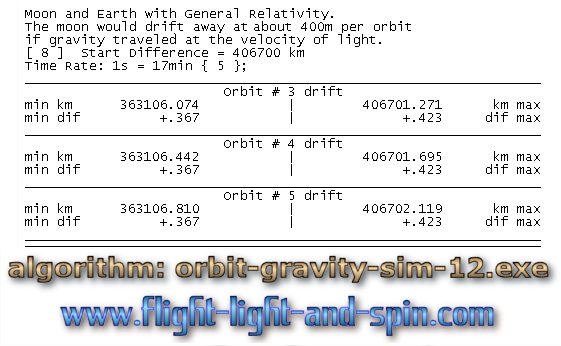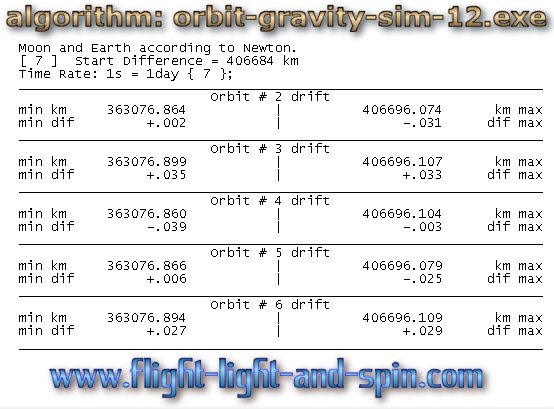| Relativity and the Moon's orbit Up
until now I had been using NASA’s planetary fact-sheet as
the most likely source of detailed data. A troubling problem on
that web-page is that whilst NASA is making the famous claim of
a 36mm recession of the Moon’s orbit from the Earth per year,
it also only gives the Moon’s orbit rounded off to the nearest
thousand kilometres! |
||
| Also note that Scenario [6] improves on Scenario [7] because it has 10 times more sides to the polygon-orbit and thus it demonstrates an error-margin of less than half-a-meter per orbit. Scenario [6] calculates at the same time-scale as Scenario [8] which then also adds the velocity of gravity from General Relativity to the orbit of the Moon. Even
though it is fairly easy to improve on this error-margin by increasing
the number of sides to the orbit-polygon, there is no real need
here, because the fluctuation caused by gravity-velocity dwarfs
the error-margin by 100 times. The results of Scenario [8]
are superb: |
||
 |
||
| The outwards spiral of 400m per orbit if gravity travels at the velocity of light would be due to the reciprocal delay between the forces of gravity between the two bodies. The Moon would be attracted to a point 16m from the Earth’s center at an earlier point on the orbit-path; whilst the Earth would similarly be pulled by the Moon to a point 1.3km away from the Moon’s center. At this rate, of an outwards spiral of 400m per orbit, the Moon would have separated from the surface of the Earth less than 70 000 years ago - if gravity moved at the velocity of light. So how is the Moon’s orbit influenced by Special Relativity? Scenario
[9] is right on the edge of what is measurable
in this algorithm because the velocity of the Moon around the
Earth is quite slower (1 km/s) than the velocity of the Earth
and Moon together around the Sun (30km/s). And here is where Special
Relativity shows a blatant contradiction: If we take the velocity
of the Moon to include the velocity that the Earth-Moon system
has around the Sun, then the Moon’s velocity is much closer
to the velocity of light – and thus it would be more greatly
altered by the reduction in velocity from Special Relativity. |
||
 |
||
| This is an extract summary of Chapter XXX of the book: Flight Light and Spin Download page for relativity simulation: algorithm orbit-gravity-sim-12.exe The full chapter can be downloaded here: Sum-Theory.pdf (5.5 mb, 57 pages, this pdf file is too big for chrome, use firefox) List of: abbreviated short articles . . |
|||||




